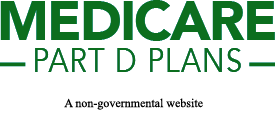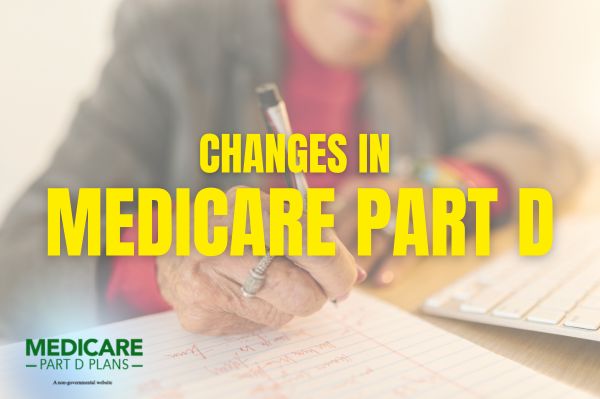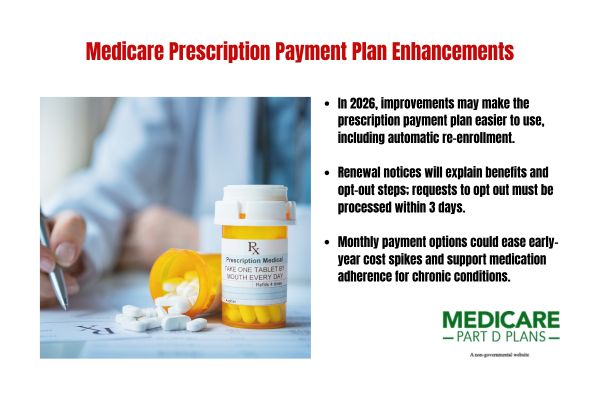Find a Medicare Part D prescription drug plan

Medicare Part D
Prescription Drug Coverage 2026
What is Medicare Part D in 2026
From the possibility of increased deductibles to additional monthly payment options, these potential changes likely stem from the Inflation Reduction Act of 2022 and may aim to make medication more affordable.
Key Takeaways
- Medicare Part D might see changes
in 2026 , such as a potential increase in the annual deductible and an out-of-pocket threshold.
- The possible introduction of the Selected Drug Subsidy Program could potentially reduce costs for beneficiaries by offering financial assistance for specific high-cost prescription drugs.
- Beneficiaries should review their Medicare plans annually to ensure they understand their changing healthcare needs and to stay informed about new policies.
Potential Changes to Medicare Part D in 2026
The Inflation Reduction Act of 2022 might mandate several updates to Medicare Part D, which could directly influence costs and coverage. These potential changes might reflect the increased costs due to inflation and medical advancements, likely impacting overall Medicare expenses.
One of the possible adjustments might be the introduction of a system that could potentially allow beneficiaries to pay their out-of-pocket prescription costs in monthly installments, possibly easing financial burdens.
Additionally, the revised methodology could help support a richer benefit structure, possibly enhancing the overall coverage provided by Medicare Part D. The final rule for Contract Year
Given the evolving nature of personal lifestyles and medical needs, annually reviewing Medicare plans could potentially ensure the plans remain suitable for beneficiaries in future years.
Annual Deductible
One of the potential changes
A higher deductible could potentially mean that beneficiaries may face higher initial costs before their prescription drug coverage kicks in, potentially causing financial strain for those who require regular medications.
The potential deductible increase will likely align with rising healthcare costs, meaning beneficiaries might anticipate higher initial expenses before Medicare Part D starts covering certain medication costs.
Out-of-Pocket Threshold
In addition to the increased deductible, the annual out-of-pocket threshold for Medicare Part D enrollees may also increase
This phase may relief by potentially reducing the participants’ prescription drug expenses after they’ve paid a substantial amount out-of-pocket.
Understanding the different stages of Medicare Part D coverage is crucial. Beneficiaries should navigate the initial coverage phase and the coverage gap before reaching catastrophic coverage, where Medicare will likely cover most drug costs.
Awareness of potential changes could help prevent surprises in prescription expenses.
Introduction of the Selected Drug Subsidy Program
Starting January 1,
The program will likely target specific medications that could help ease the financial burden for individual’s dependent on high-cost drugs.
The Selected Drug Subsidy Program may be part of a broader effort to control rising drug costs and possibly improve access to necessary medications.
A government subsidy for selected drugs could potentially make prescription medications more affordable and accessible, likely allowing beneficiaries to manage their health effectively and enjoy certain drug benefits.
Medicare Prescription Payment Plan Enhancements
The Medicare Prescription Payment Plan might see updates
Renewal notices will be sent out with adjusted timing requirements to facilitate this process.
Additionally, the redesign program instructions might allow Medicare Part D enrollees to pay their out-of-pocket prescription costs in monthly installments through certain Medicare Part D plans.
This could potentially reduce the financial burden on beneficiaries, likely making it more manageable to cover some of the costs of necessary medications throughout the year.
These potential enhancements likely demonstrate a commitment to improving the overall Medicare experience for beneficiaries.
Simplified Determination Methodology for Creditable Coverage
The determination methodology for creditable coverage under Medicare Part D may require groups to cover at least 72% of each member’s drug expenses.
The revised methodology will likely aim to ensure that comprehensive coverage could be provided to beneficiaries, possibly enhancing the overall value of prescription drug plans.
The updated methodology may benefit beneficiaries and aligns with Medicare Part D’s actuarial equivalence standards, possibly ensuring coverage quality meets or exceeds Medicare offerings.
This potential change could be crucial for both plan sponsors and beneficiaries, as it might impact the revised simplified determination method of creditable coverage status.
Implications for Employers
Employers should take note of the potential updates in creditable coverage under Medicare Part D. Compliance may require adjusting health plans to offer at least 72% coverage of drug expenses, maintaining the plan’s creditable coverage status, and avoiding penalties.
Reviewing guidance for group health plans will likely ensure compliance with new regulations. An advisory committee may help with staying informed, which could be vital for supporting employees, fulfilling employer obligations, and minimize potential risks in the employer group market.
Possible Impact on Employees
Potential changes in creditable coverage status may also be significant for employees. Employers should notify Medicare Part D-eligible plan participants yearly about their plan’s creditable coverage status, which informs employees whether their plan meets Medicare Part D standards.
If a plan has been deemed non-creditable, employees will likely have the option to switch their employer plans coverage without facing penalties. This flexibility could be vital for employees to ensure they have adequate coverage and potentially avoid unexpected out-of-pocket expenses.
See plans in your area instantly!
Advertisement
Medicare Drug Price Negotiation Program
The Medicare Drug Price Negotiation Program, likely introduced by the Inflation Reduction Act of 2022, might allow Medicare to negotiate prices for certain high-cost drugs without generic alternatives.
The process will likely involve assessing the drug’s market data and clinical benefits, with drug companies required to respond to CMS’s final price offers.
The maximum fair price established through this negotiation could potentially impact beneficiaries’ cost-sharing for these drugs.
By potentially reducing the negotiated price of high-cost medications, this program will likely aim to lower overall drug costs for Medicare beneficiaries, possibly making prescription drugs more affordable at maximum fair prices and addressing drug prices.
Cost Sharing Adjustments
During the coverage gap phase, beneficiaries may continue to pay about 25% of the costs for their covered medications. These potential adjustments might offer a more predictable and manageable cost structure for beneficiaries, possibly lowering overall out-of-pocket expenses.

Permanent Zero Cost-Sharing for Adult Vaccines
Medicare Part D might implement a permanent zero cost-sharing policy for adult vaccines recommended by health authorities. This initiative might improve vaccination rates among adults by possibly eliminating financial barriers that may prevent individuals from getting vaccinated.
Making this policy permanent could potentially ensure beneficiaries could access crucial immunization practices without financial worry, likely promoting better public health outcomes.
Potential Cap on Insulin Costs
In a move to potentially alleviate some of the financial burden on those with diabetes, Medicare might implement the following:
- Cap the cost of insulin at about $35 for a one month supply.
- Apply this potential cap to each covered insulin product.
- Beneficiaries might not have to pay more than the specified amount for their necessary medication.
A deductible may not apply to the capped insulin costs, possibly enhancing affordability for diabetes management. This potential change could be a crucial step in making essential medications more accessible and affordable for those relying on insulin.
Review Your Medicare Plan Annually
With numerous potential changes in Medicare Part D, beneficiaries should review their Medicare coverage annually. The possible costs, benefits, and healthcare providers may change yearly, affecting the value and suitability of a plan.
Reviewing plans could potentially ensure beneficiaries have the best coverage for their evolving healthcare needs.
Annually, Medicare beneficiaries may change plans, switch between different plans, or retain their current coverage. For assistance, beneficiaries can seek unbiased guidance through their state’s SHIP program, which helps review Medicare options.
Find a Plan and Enroll Online Yourself!
Advertisement
Summary
As we look ahead to
Possible changes might include increased deductibles, higher out-of-pocket thresholds, and the introduction of new programs that may help reduce certain costs and coverage. Understanding these potential changes will likely be essential for making informed decisions about Medicare plans.
By staying informed and reviewing plans annually, beneficiaries could ensure they have the best possible coverage to meet their healthcare needs. As Medicare continues to evolve, being proactive and knowledgeable could help beneficiaries navigate the potential changes and maximize their benefits.
Frequently Asked Questions
What is the annual deductible for Medicare Part D in 2026 ?
The annual deductible for Medicare Part D will likely be set around $615
What is the out-of-pocket threshold for Medicare Part D enrollees in 2026 ?
The out-of-pocket threshold for Medicare Part D enrollees may be set to approximately $2,100. It’s important to be aware of these costs to plan your healthcare expenses effectively.
When does the Selected Drug Subsidy Program start?
The Selected Drug Subsidy Program starts on January 1,
How much will Medicare beneficiaries pay for a month’s supply of insulin in 2026 ?
Medicare beneficiaries may have to pay around $35 for a month’s supply of each covered insulin product
Why is it important to review Medicare plans annually?
Reviewing Medicare plans annually may be crucial as costs, benefits, and healthcare providers might change, potentially affecting the plan’s suitability for your needs. Staying informed could help ensure that you make the best choice for your healthcare.

Begin Choosing your plan
Advertisement
ZRN Health & Financial Services, LLC, a Texas limited liability company.


